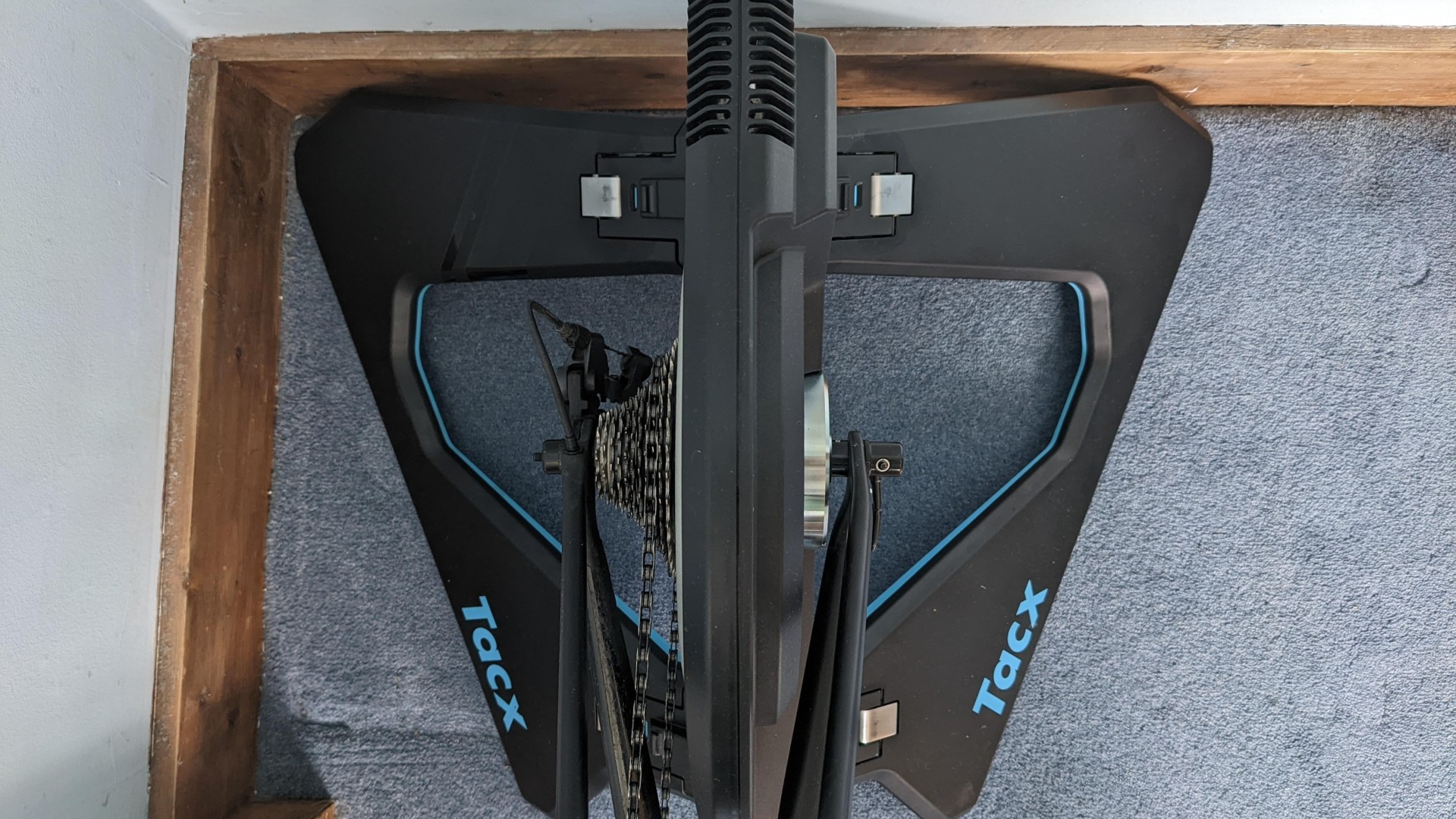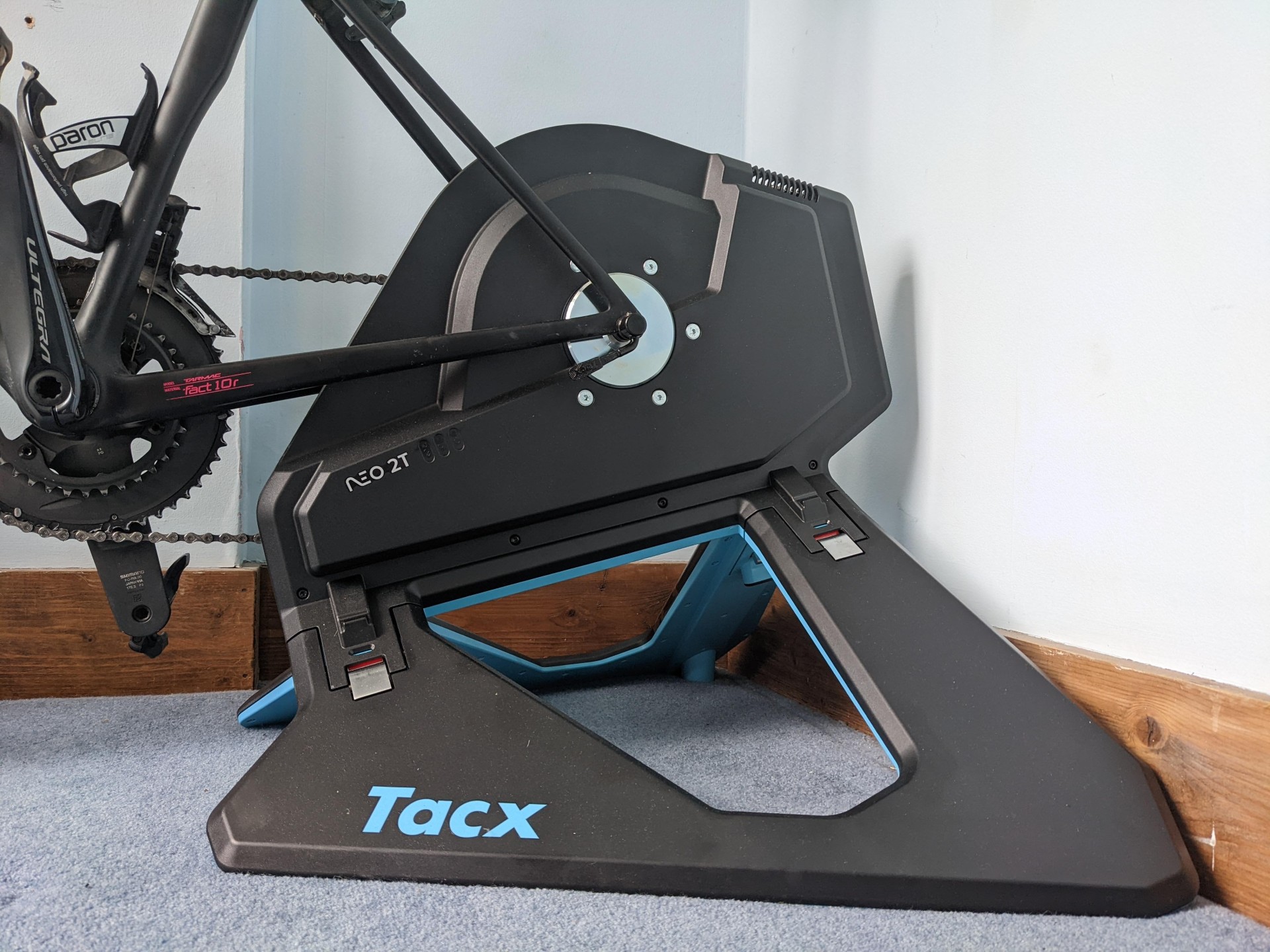Our Verdict
The performance and the feel of the ride is the best you can get from a direct drive turbo trainer, but it’s also the most expensive. If you’re not an elite rider it’s hard to justify the extra expense over its rivals.
For
- No need to calibrate
- Limitless performance potential
- Most realistic ride feel for a turbo trainer
- Power source not required
Against
- Price
- Doesn’t come with a cassette pre-installed
- Hard to manoeuvre
- Can’t be folded away with bike installed
You can trust Coach
Although not well known outside cycling circles, Tacx has been manufacturing well-respected indoor trainers since 1972. The Dutch brand, which US giant Garmin acquired in 2019, released its first smart direct drive turbo trainer in 2015, and the Neo 2T is its latest version.
It’s the brand’s top-of-the-line turbo trainer (although you can upgrade to the Tacx Neo Bike if money is no object), and is a direct competitor to Wahoo’s top-end Kickr V5 and the Saris H3. But does it blow the best turbo trainers out of the water?
Tacx Neo 2T: Price & Availability
The Tacx Neo 2T was released in September 2019 and costs $1,399.99 in the US and £1,199.99 in the UK (although, at the time of writing, we’ve seen it listed for £959).
The Wahoo Kickr V5 costs $999.99/£999.99 and the Saris H3 costs $899.99/£899.99.
The Neo 2T is the top-of-the-range Tacx turbo trainer and is a step up in features and build quality from its second-tier direct drive model, the Flux 2 ($899.99/£699). The brand also makes wheel-on models (the $299.99/£229.99 Boost and $369.99/£269.99 Flow), rollers, and the previously mentioned Neo Bike.
Specs & Hardware

It’s easy for your eyes to glaze over when looking at turbo trainer specs, but these really do stand out. The Neo 2T packs a maximum output of 2,200w, the ability to simulate gradients of 25%, and power, speed and cadence accuracy of +/- 1%. What does this mean for the average user? Unless you’ve got the sprinting prowess of Mark Cavendish, gobble up Alpine climbs for breakfast and are training for your own tilt at the Tour de France (and your coach needs uber-detailed data), you can safely assume that you’ll never reach the limits of Neo 2T’s potential.
These hard numbers match or beat the competition, but it also has a few other tricks up its sleeve to set it apart. The design allows for a degree of side-to-side movement when out of the saddle, its virtual flywheel can simulate the feeling of descending, and it even has a “road feel” feature that provides haptic feedback through your pedals whenever you’re riding over the rough stuff in virtual worlds.
Sign up for workout ideas, training advice, reviews of the latest gear and more.
Throw in auto-calibration, the ability to be used without a power source, and quiet operation (my wife, in another room, said she heard a subtle whooshing sound rather than the house-shaking hum that come from some turbo trainers), and it was en route to being one of the best turbo trainers I’ve tested.
The Set-Up
The Neo 2T lost marks straight out of the box. Unlike the Wahoo Kickr it doesn’t come with a cassette pre-installed. Tacx recommends installing a new cassette and chain to keep everything running smoothly and quietly.
If you have the means (a chain whip, lock ring tool and spanner), installing one yourself is relatively simple, but will require you to buy a new cassette or use the one from your wheel, which makes switching between indoor and outdoor training more time-consuming. If you don’t have these tools to hand, or prefer the act of riding your bike to tinkering with it, it’ll require a trip to your local bike shop. I chose to remove the cassette from my wheel and install it on the freewheel.
Before you can get to this stage, you have to unfold the turbo. This is made up of a central piece and two legs that fold down like the wings of an Imperial shuttle from Star Wars, with feet that snap into place with a satisfying click and elevate the body of the turbo trainer off the ground. It’s then just a case of installing the cassette, connecting your bike’s chain to it, slotting it onto the turbo, and tightening the included quick-release skewers. The Neo 2T is also compatible with thru-axles and adapters, and instructions on how to swap them are included in the box.

Slot your front wheel into the included riser block and that’s it. You don’t even need to plug it in to a power source, although it’s recommended if you want to make the most of all the features and for ease of pairing with third-party apps such as Zwift.
It is worth pointing out that, once the Neo 2T is set up, you won’t be moving it without uninstalling your bike from the turbo. It doesn’t have a handle like the Wahoo Kickr to let you manoeuvre it easily, which is a handy feature if you don’t have the luxury of a dedicated indoor training space. The legs also can’t be folded up when the bike is on it, unlike the majority of turbo trainers, so it takes up a sizeable amount of space whether it’s in use or not.
The Ride
When spending four figures on a turbo trainer, you’d expect the ride to be one of the most realistic ones around and the Tacx Neo 2T doesn’t disappoint. While platforms such as Zwift have their critics, the visual stimulus of virtual worlds has transformed the experience of indoor cycling. The Neo 2T takes the immersion up a notch, producing the most authentic recreation that I’ve ever felt when pedalling away on a turbo.
When exploring at your own pace, the virtual flywheel responds as your bike would on the road, while the gentle vibrations from riding over in-app cobblestones or boardwalks are surprisingly close to the real sensation. The turbo also allows for a certain degree of side-to-side sway too, which adds to the realistic feel. Short of investing in additional accessories that help simulate climbs and descents (such as the Elite Rizer), this is the closest you’ll get to outdoor riding indoors.
When used in ERG mode, where resistance is changed automatically as you progress through a workout rather than simulating the virtual world’s gradients, I found that it fluctuated above and below the target watt output a lot more erratically than the Wahoo Kickr I tested, which held a fairly steady maximum output. While this didn’t affect the intensity of the training session, I preferred the rigid cap of the Kickr’s ERG mode.
Is The Tacx Neo 2T Worth It?
The Tacx Neo 2T is the most expensive direct drive turbo trainer currently available. The RRP is more than most people would spend on a bike, and the lack of pre-installed cassette adds an extra expense.
Tacx can point to the fact that it is trusted by a number of elite athletes across the men’s and women’s professional pelotons, but if you’re reading this, there’s a good chance you’re not going to be making an attempt to claim the yellow jersey any time soon. Compared with its direct rivals, I don’t think that the Tacx Neo 2T does enough to justify the additional outlay. Sure, it’s got great performance specifications and fun experiential features, but it’s not very practical when you might need to pack it away for 23 out of 24 hours a day.
If money is no object and you have the space for a dedicated pain cave, the Tacx Neo 2T is a worthy centrepiece that will provide hours of (type 2) fun. But if you need something more compact and can make do with imagining what some virtual cobbles feel like, then you’ll be better off with one of the alternatives. If you’re in the market for a model that you can grow into without breaking the bank, I suggest investing in either the Wahoo Kickr Core or the Tacx Flux 2.
Charlie Allenby is a journalist with a passion for pedalling. He contributes features and buying advice about cycling, and is Coach’s dedicated turbo trainer reviewer. He is also Coach’s chief whey and casein protein powder tester, trying as many brands as possible.
Charlie’s first book, Bike London, is out now. He has written for The Guardian, The Independent and BikeRadar, among others.


